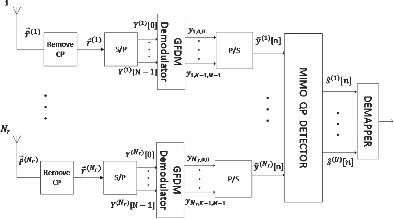当前位置:
X-MOL 学术
›
Trans. Emerg. Telecommun. Technol.
›
论文详情
Our official English website, www.x-mol.net, welcomes your
feedback! (Note: you will need to create a separate account there.)
Low‐complexity receivers for massive MIMO‐GFDM communications
Transactions on Emerging Telecommunications Technologies ( IF 2.5 ) Pub Date : 2021-01-26 , DOI: 10.1002/ett.4219 Hsuan‐Fu Wang, Fang‐Biau Ueng, Ye‐Shun Shen, Kai‐Xiang Lin
Transactions on Emerging Telecommunications Technologies ( IF 2.5 ) Pub Date : 2021-01-26 , DOI: 10.1002/ett.4219 Hsuan‐Fu Wang, Fang‐Biau Ueng, Ye‐Shun Shen, Kai‐Xiang Lin

|
The orthogonal frequency division multiplexing (OFDM)‐based modulation scheme is widely utilized in asymmetric digital subscriber lines (ADSL), wireless local area networks (WLAN), and the fourth generation (4G) of mobile communication systems due to its ability to cope with severe channel conditions without complex equalization processes. However, the drawbacks of OFDM such as: requirement of a high peak to average power ratio (PAPR) radio frequency (RF) power amplifier, sensitive to carrier frequency offset, high out‐of‐band (OOB) emissions cause the OFDM is not applicable for the fifth generation (5G) mobile communication application scenarios such as machine‐type communications (MTC), Internet of things (IoT), and cognitive radio (CR). Generalized Frequency Division Multiplexing (GFDM) modulation scheme has regarded as one of the promising candidates for 5G waveforms due to its properties, such as low latency, low OOB emission, robust against carrier frequency offset (CFO), and time offset (TO). The GFDM is also combined with massive multiple‐input multiple‐output (MIMO) technology that equipping each base station (BS) with an array of many active antennas, which are used to spatially multiplex many user equipment (UE) to improve spectrum efficiency (SE). However, as the modulation order and the number of antennas increases, the complexity of the maximum likelihood (ML) detector and the minimum‐mean‐square‐error (MMSE) detector causes an impediment for real‐world applications. This paper proposes a low‐complexity detector configuration which utilizes quadratic programming principle. The simulations show that the computation complexity of the proposed detector is lower than the ML detector and the bit‐error‐rate performance of the proposed detector is better than that of the MMSE detector.
中文翻译:

适用于大规模MIMO-GFDM通信的低复杂度接收机
基于正交频分复用(OFDM)的调制方案因其能够应对非对称数字用户线(ADSL),无线局域网(WLAN)和第四代(4G)移动通信系统而得到广泛使用恶劣的信道条件,而无需复杂的均衡过程。但是,OFDM的缺点包括:要求高峰均功率比(PAPR)射频(RF)功率放大器,对载波频率偏移敏感,带外(OOB)高发射导致OFDM不适用于第五代(5G)移动通信应用场景,例如机器类型通信(MTC),物联网(IoT)和认知无线电(CR)。通用频分复用(GFDM)调制方案由于其特性,例如低等待时间,低OOB发射,对载波频率偏移(CFO)的鲁棒性和时间偏移(TO)而被视为5G波形的有希望的候选者之一。GFDM还与大规模多输入多输出(MIMO)技术相结合,为每个基站(BS)配备了许多有源天线阵列,这些天线用于空间复用许多用户设备(UE)以提高频谱效率( SE)。但是,随着调制阶数和天线数量的增加,最大似然(ML)检测器和最小均方误差(MMSE)检测器的复杂性给实际应用带来了障碍。本文提出了一种利用二次编程原理的低复杂度检测器配置。仿真结果表明,所提出的检测器的计算复杂度要比ML检测器低,并且所提出的检测器的误码率性能要优于MMSE检测器。
更新日期:2021-04-05
中文翻译:

适用于大规模MIMO-GFDM通信的低复杂度接收机
基于正交频分复用(OFDM)的调制方案因其能够应对非对称数字用户线(ADSL),无线局域网(WLAN)和第四代(4G)移动通信系统而得到广泛使用恶劣的信道条件,而无需复杂的均衡过程。但是,OFDM的缺点包括:要求高峰均功率比(PAPR)射频(RF)功率放大器,对载波频率偏移敏感,带外(OOB)高发射导致OFDM不适用于第五代(5G)移动通信应用场景,例如机器类型通信(MTC),物联网(IoT)和认知无线电(CR)。通用频分复用(GFDM)调制方案由于其特性,例如低等待时间,低OOB发射,对载波频率偏移(CFO)的鲁棒性和时间偏移(TO)而被视为5G波形的有希望的候选者之一。GFDM还与大规模多输入多输出(MIMO)技术相结合,为每个基站(BS)配备了许多有源天线阵列,这些天线用于空间复用许多用户设备(UE)以提高频谱效率( SE)。但是,随着调制阶数和天线数量的增加,最大似然(ML)检测器和最小均方误差(MMSE)检测器的复杂性给实际应用带来了障碍。本文提出了一种利用二次编程原理的低复杂度检测器配置。仿真结果表明,所提出的检测器的计算复杂度要比ML检测器低,并且所提出的检测器的误码率性能要优于MMSE检测器。











































 京公网安备 11010802027423号
京公网安备 11010802027423号